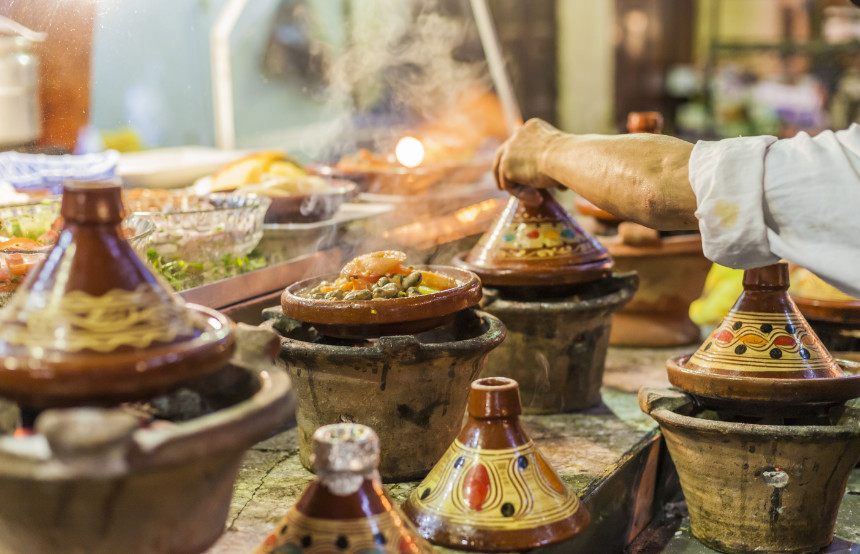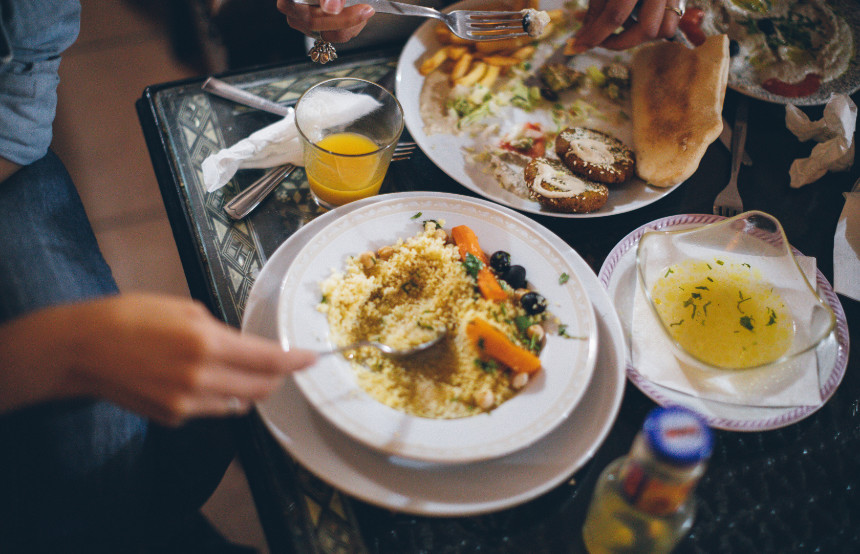Morocco is known for its colourful culture and dazzling diversity. This vibrancy and variety extends beyond the ancient cities and chaotic souqs to the equally rich culinary tradition where subtle spices, aromatic flavours and captivating combinations grace the smorgasbord of dishes that comprise Moroccan cuisine. Immersing yourself in the gastronomic world of another country is one of the best ways to experience a new culture, and when the food is as flavourful as Morocco’s, getting a taste for a new place is a fairly easy task. Read on to find out about our favourite traditional food in Morocco…
Couscous
Couscous has become commonplace within many world cuisines and recipes, however it originated among the Berbers of Morocco in the 11th century and the name comes from the Berber word k'seksu. The fine wheat pasta, which is traditionally rolled by hand and is now the national dish of Morocco, is normally served with meat, vegetables and sauce, although in the Berber tradition it is sometimes combined with raisins and buttermilk.

Tagine
Perhaps one of the most well-known Moroccan dishes, tagine takes pride of place on our list of traditional food in Morocco. Tagine actually refers to both the stew and the clay cooking pot used to cook it, and the stew can take many different forms, meaning you’re bound to find a version you like whatever your dietary preference. Some popular options include kefta tagine (minced beef or lamb, cooked with garlic, coriander and parsley) and traditional slow-cooked lamb tagine.
Harira
The country’s commitment to spices and seasoning is particularly evident when it comes to harira, a rich and fragrant Moroccan soup. The warming dish is made with tomatoes, lentils, chickpeas, garlic and a generous helping of herbs and spices (including parsley, coriander, ginger, pepper, cinnamon and turmeric). It’s often the dish of choice for breaking fasts at sunset during Ramadan and is sometimes served with chebakia, a honey-soaked fried pretzel.
Zaalouk
It’s commonplace for an array of dips and salads to be served at the beginning of a Moroccan meal, with crusty bread as the accompaniment for scooping up the starters. Zaalouk is one of the most popular, and for good reason, as this smoky aubergine dip is packed with flavour (thanks to the copious amounts of garlic, paprika, cumin and chilli powder which are added).
Bastilla
Traditional food in Morocco often blurs the lines between sweet and savoury, and somehow it works every single time. Bastilla is a pastry pie, originating from Fez, made from layers of wafer-thin pastry filled with chicken or pigeon meat, almonds, eggs, coriander and saffron, sprinkled with cinnamon and icing sugar.
Fish Chermoula
Morocco’s Atlantic Coast is punctuated with charming fishing villages and traditional ports, which provide the freshly-caught seafood that dominates many of the nation’s authentic dishes. Chermoula is a popular North African marinade that pairs particularly well with mackerel or flaky white fish, such as cod. The condiment’s ingredients can vary, but usually consist of garlic, coriander, paprika, cumin, ginger and cayenne. After marinating the fish in the spicy sauce, it’s then grilled over coals and served with couscous or rice.
Makouda
Our list of traditional food in Morocco wouldn’t be complete without the addition of some street food and makouda (deep-fried potato balls) are a widespread offering worth sampling. The batter is relatively simple - made from mashed potato, flour, egg and oil - although it can be livened up with the inclusion of garlic, hot pepper and cheese. Spicy harissa sauce is a good accompaniment, and you’ll find the dish being served in the food markets of Morocco’s major cities.
Mint Tea
It might seem counterintuitive to drink tea in a country as warm as Morocco, however the warm beverage traditionally signifies hospitality and affection, so is often prepared when meeting with friends and family. Nicknamed ‘Moroccan whisky’, it’s made by brewing fresh spearmint leaves with lots of sugar and served by pouring it into a tea glass from a height. This is considered to be an act of respect towards the guest and creates froth at the top, called the crown.
Written by Luisa Watts














